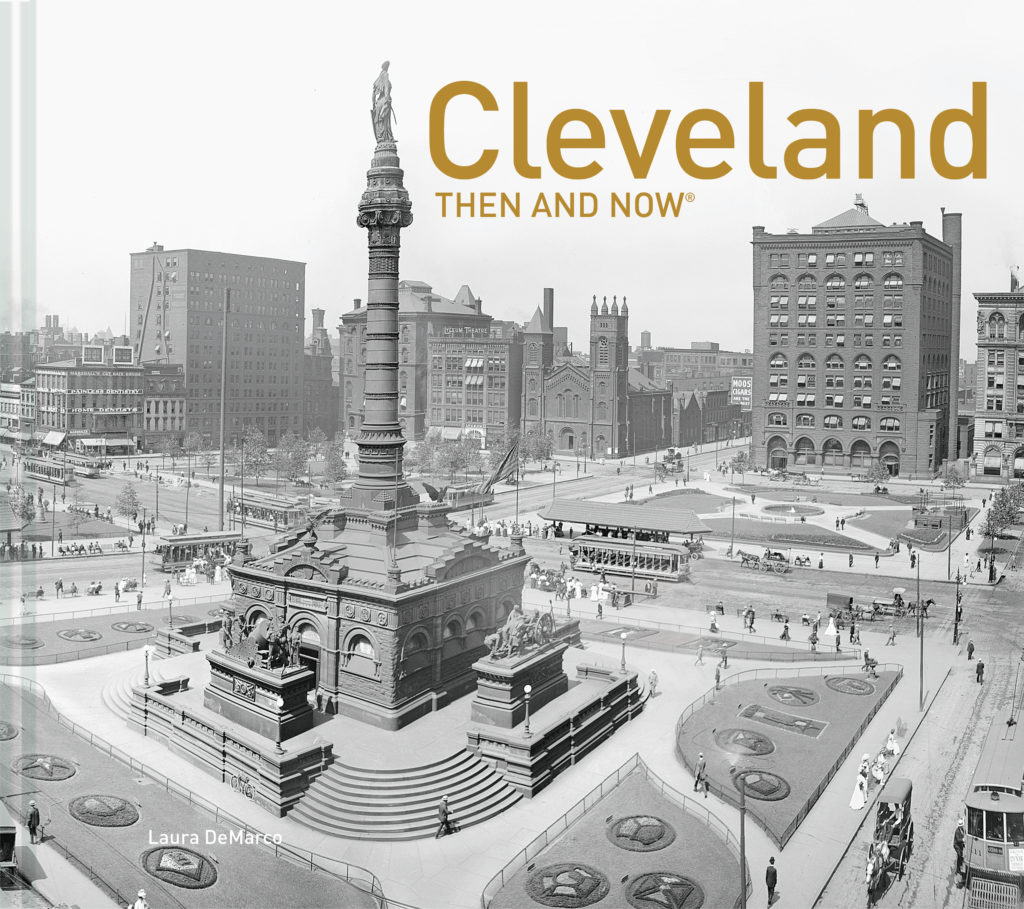
Sun 11/25 @ 11AM-2PM
Everyone has a personal history of Cleveland, which invariably leads to memories and questions about the past.
Whether it’s the Old Stone Church, where my grandparents Agnes and Norman Walter were married, or the old Halle Building where my great-grandmother sold gloves, it’s hard not to travel down East 9thand wonder what was around the corner a century ago.
Answering those questions and more is Laura DeMarco, who first explored Cleveland’s iconic architecture and demolished buildings in her 2017 book Lost Cleveland. Now the reporter and author returns with Cleveland Then and Now, with 144 pages and 150 photos juxtaposing rare vintage images with colorful, modern-day photos.
DeMarco has scheduled a Cleveland Then and Now launch event for November 25 at the Prosperity Social Club. The venue is apropos considering it’s been open as a Tremont pub for 80 years.
CoolCleveland talked to DeMarco about her favorite photos and memories found in Cleveland Then and Now.
CoolCleveland: Looking back to Lost Cleveland, how did that book lead you to Cleveland Then and Now?”
Laura DeMarco: I’m a lifelong Clevelander, and I know we Clevelanders really love our city and to talk about our city. I was overwhelmed by how much people wanted to talk about Lost Cleveland. I did a lot of library talks and they were usually crowded with people who wanted to share their Cleveland stories. A lot of them wanted to talk about the past, but they wanted to talk about what was here now. Places that weren’t lost, but maybe that were very different, like the West Side Market or Playhouse Square, Edgewater Park. That’s really how the idea for this came about, looking at the places that aren’t all turned into parking lots.
CC: There’s no denying every @SkrticX tweet by Cleveland Public Library Director of Public Services John Skrtic of an old downtown Cleveland photo requires a stoppage of work to peruse the past. Why are these photo so appealing?
LD: I think it’s because the city has changed so much. Cleveland has had a particularly dramatic 20thcentury. We were this grand city — the fifth largest, almost a million people in the 1920s — and we had all of these rich industrialists here who besides their factories gave money for these grand institutions. When Cleveland fell on hard time in the 1960s and a lot of places started to close and people started to leave, we had all of these things left around. So today Cleveland doesn’t look that much like it did yesterday.
CC: How much fun was it to sift through Cleveland’s past?
LD: It was so exciting. I love digging through archives. I spent a lot of time with John Skrtic and his staff in the Cleveland Public Library. You’d put on white gloves and say, “Can I see all of your E. 9thand Euclid pictures?” They’d bring out hundreds of photos. Also, I visited the Library of Congress, Cleveland Press archives at Cleveland State University and the Western Reserve Historical Society.
CC: How did you approach the modern photos?
LD: I worked with Pavilion Books, which has a photographer who is with the San Jose Mercury News. I sent him all of the vintage photos, and then he came to town for a week and a half driving around Cleveland and researching so he could take the exact same photo from the exact angle, time of day, everything at that spot.
CC: The book is based on a something old, something new presentation. Why is that so effective?
LD: I think they work as a pair. Every day we walk around and see the places. For example, seeing the E. 9thStreet pier. We know what it looks like now, but being transported to the past 50 years to see old Cadillacs and guys on the pier fishing and hanging out is pretty interesting. Mostly I was looking at transformed places in Cleveland that sort of tell about our highs and lows and where we are now and where we were before.
CC: What are a few of your favorite locations found in the book?
LD: I think Playhouse Square because that’s really the most important transformation in Cleveland history. Without that being saved, I don’t think downtown Cleveland would have come back like it has. I also love the pictures of the (Cuyahoga) River when it really was a working town, just boats and smoky skies. Actually, I like the Public Square picture on the cover a lot because it kind of shows you how its layout hasn’t changed thanks to that renovation and restoration in 2016.
CC: It is fair to say Cleveland Then And Now gives the reader a feeling of optimism?
LD: I hope people take away the fact that change is not always good and not always bad, and a city is living organism. Like any American city, we’ve had our ups and downs, which maybe are a little bit more dramatic than some. And we’re not what we were, but we have a lot of great things now.

Cleveland, OH 44113
One Response to “Laura DeMarco Explores “Cleveland Then and Now” with New Photo Book”
SONDRA ELLEN JORDAN
I would like information on having you present a program for our Willoughby womens club, Willoughby ohio
sincerely Sondra Jordan 440 354 8851 will be waiting to hear from you.